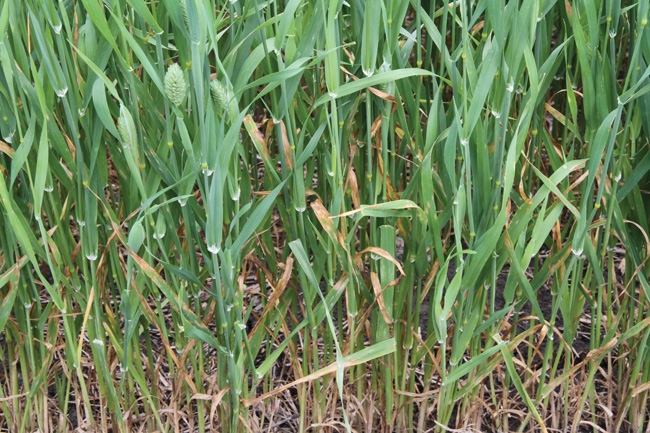
Features
Fungicides
Seed & Chemical
Septoria leaf mottle control on canaryseed
For canaryseed growers, septoria leaf mottle, caused by Septoria triseti, is the major disease of concern that can cause economic damage. Previous research has shown that this disease can reduce yields by 30 percent under the right conditions for disease development. Scouting for the disease and using registered fungicides for control are important strategies.
“Septoria leaf mottle seems to be more of a problem in the eastern part of Saskatchewan than in the western half,” says Bill May, crop management agronomist with Agriculture and Agri-Food Canada in Indian Head. “In wet years, we have seen a 30 percent yield response to a fungicide application. However, in recent years we have had trouble seeing a yield response in small plots, but not on a field scale. We hope to conduct another research project to determine why we are seeing this difference and to find a better way of predicting when septoria leaf mottle will be a problem in canaryseed.”
Septoria leaf mottle seems to be a disease specific to canaryseed and so far has not been found on other crops. It is a residue-borne disease, so crop rotations that leave at least two or three years between canaryseed crops are a good idea. Fields adjacent to canaryseed stubble are considered high risk. Using clean, disease-free seed is also recommended. Other minor diseases of canaryseed that typically do not result in economic damage include ergot, fusarium head blight, common root rot and spot blotch.
“In a wet year and with a heavy canopy, growers can expect to have more problems with septoria leaf mottle,” explains May. “The bigger the canopy and the wetter the conditions, the more you have a concern. Propiconazole (Tilt, Bumper, Pivot and Propel) is registered for control and in our trials it has provided excellent control of septoria leaf mottle. Check fungicide labels and talk to companies to see if products are registered for use on canaryseed.”
Scouting for the disease is important, and with practice early symptoms of septoria leaf mottle are not difficult to recognize. “The first noticeable systems are mottled green islands on the bottom leaves,” says May. Green islands are infected spots that remain green as the rest of the leaf yellows. The infection is caused by pycnidia, or small, black, spore-producing bodies that look like pepper sprinkled on the leaf and can be difficult to see. While scouting for septoria leaf mottle, growers can also look for aphids. However, aphids usually don’t show up until after the crop has headed out.
The best time for a fungicide application on canaryseed is at flag leaf and head emergence. “The thing to remember with canaryseed is the flag leaf is wrapped around the head when it emerges,” explains May. “In our canaryseed plots, we often don’t get canopy closure until full head emergence. However, if you observe a major infestation of the disease in the early flag leaf stage, you can definitely apply a fungicide. Once canopy closure occurs, wet weather will spur the development of the disease. If the septoria leaf mottle moves into the middle third of the canopy off the bottom leaves before seed development has started, then a fungicide application is likely warranted.”
March 2, 2012 By Donna Fleury
 Septoria leaf mottle in canaryseed field. For canaryseed growers
Septoria leaf mottle in canaryseed field. For canaryseed growers